Suppressing White Mold; Volunteer Corn Control; Crop Critters
BY Dairyland Seed Agronomy Team
WHITE MOLD SUPPRESSION IN SOYBEANS
Conditions that usually create a white mold year are lower than normal temperatures (below 85°F) and above average precipitation or high humidity around the time of flowering. With most of the region already experiencing these conditions, and weather predictions for continued below average temperatures, this raises concerns for white mold risk this year.

The white mold fungus, Sclerotinia sclerotiorum, primarily infects the soybeans through senescing flowers around the R1-R3 (first flower – beginning pod) stage. Symptoms don’t usually appear until the R4-R6 (full pod – full seed) growth stages. Foliar symptoms are interveinal coloring of grey-green and can resemble other soybean diseases such as brown stem rot or stem canker. Fluffy white mycelium growth can be found on the stems near the nodes. Leaves of infected plants eventually die but remain attached to the stem.
Areas to Watch:
Fields with a history of white mold will be at a higher risk for developing white mold again due to the increased inoculum. It is also important to note that the sclerotia (small, black overwintering structures) can persist in the soil for several years.
- Highly productive fields tend to produce excessive vegetative growth which restricts airflow through the canopy and, therefore, is more favorable for white mold.
- Narrow row spacing and high populations will also contribute to restricted airflow through the canopy and should be monitored.
- Fields planted to soybean varieties with low white mold tolerance are at a higher risk for developing white mold.
In-Season Management
There are several products available that are considered “good” for controlling white mold. Some examples of these products are Aproach®, Endura® and Propulse® fungicides. Other options can be found on the Fungicide Efficacy Chart from Crop Protection Network at https://cropprotectionnetwork.s3.amazonaws.com/CPN1019_FungicideEfficacyControlSoybean_final2.pdf.
Keep in mind that proper timing and proper application is crucial when using a fungicide for white mold control. The most effective fungicide timing is at R1 (first flower) but some affect can still be seen up to R3 (beginning pod). However, once white mold symptoms are apparent, fungicides will not be effective. Since timing is so critical, modeling tools like Sporecaster, have been developed to predict the apothecia (fruiting body that shoots spores) risk. Sporecaster is a free phone application that combines field information with research-based models to predict the best time for white mold treatment. If there is a risk factor above 40 percent during flowering, then a fungicide application should be considered.
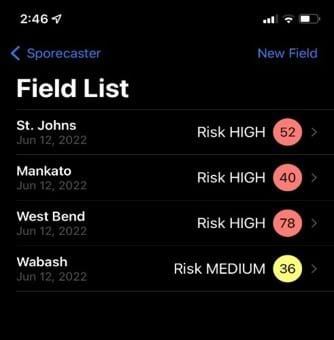
Helpful Sprayer Tips:
- Target mid to lower canopy
- Sprayer volumes of 15-20 GPA
- Slower application speeds, 10 MPH or less
- Spray pressure of 40 PSI or more
- Be sure to spray straight down into canopy
- Adding a quality spray deposition aid to your tank mix.
If you have any additional questions, please contact your Dairyland Seed Regional Agronomist
VOLUNTEER CORN CONTROL
The photo below shows a volunteer corn plant in a soybean field. Another word to describe this volunteer corn plant is, “it’s a weed”, and a weed, is a plant that is growing where it is not supposed to be growing. A weed competes with the intended crop for space, water, light and nutrients, and the value or cost of water and nutrients has not gone down in recent history. Over the years I have been told that “a volunteer corn plant here and there in your soybeans is not worth the cost to kill it”. And, in one memorable instance, “my elevator doesn’t dock for it, and really, when is the last time you were able to get $8 to $9 for your corn.” Which considering recent soybean prices being $13 to $17, you could insert those numbers instead.

Some of the more apparent concerns with volunteer corn is the fact that it reduces your soybean yield 10 to 20 percent. Various studies from land grant institutions have shown this. So, how much corn equates to a 10 percent yield loss? Only about six volunteer corn plants per 100 foot of row will achieve that amount of loss. Another rule of thumb is 2.4 volunteer corn plants per 100 sq. ft. can reduce yield by 10 percent. (For those of us that used to walk beans with a hoe, that hoe is about 5 foot in length. So if you took two hoe lengths long and two hoe lengths wide, that would give you 100 sq. ft.) These yield losses are on top of the water and nutrients that were not used by the intended crop.
Some of the unintended consequences of not controlling volunteer corn, is that this weed, can attract corn rootworm beetles to those plants and then potentially lay eggs which reduces the benefits or advantage of a crop rotation, thus creating a bigger threat to next year’s corn crop. There has been some discussion that by not controlling volunteer corn in soybeans, if the previous year’s corn crop was a B.t. corn rootworm event, that with the potential of reduced levels of expression of B.t. in those plants, we could select for resistance to these B.t. events. If this were to happen, it is not a good scenario for anyone.
Another concern with having volunteer corn plants, we are also allowing diseases such as Northern Corn Leaf Blight, Gray Leaf Spot, Goss’s Wilt as well as numerous others an opportunity to infect plants in the rotation year. This potentially sets up the next or future crops for more disease pressure which, again, defeats one of the reasons of rotating from one crop to the other.
Lastly, if you have already controlled your volunteer corn, good job. If you are still in the process of doing that, and using a volunteer corn product to accomplish this, remember you will need to increase your volunteer corn herbicide rate 30 to 50 percent when tank mixing with a broadleaf herbicide. The addition of surfactants and oils will increase the effectiveness of your volunteer corn control, however, check the herbicide labels of the products you are using to see if this is allowed and or for recommended rates. If you have questions about this or other Agronomic topics, please contact your Dairyland Seed Agronomist.
CROP CRITTERS
As is the case every year, there are plenty of insect issues across our growing area. At times they are localized and with others they are more widespread across the whole Dairyland Seed marketing area. The immediate threat for these pests is described below.
Dairyland Seed Agronomist, Mark Gibson, has observed Asiatic Garden beetle (AGB) activity in northern Indiana this year. Having been in the U.S. for close to 100 years, AGB isn’t a new pest. It is new, or of increased importance, in this area of the U.S. They prefer sandier soil types hence the reason they are being noticed in the northern Indiana sands. The grubs will feed on a variety of plant roots and will feed on corn and soybeans. Rescue measures are limited. However, preventative measures may prove more effective. Typical field sanitation is one key component as AGB can feed and survive on many weed species. Soil applied insecticides and high-rate seed applied insecticide can offer some protection as well.
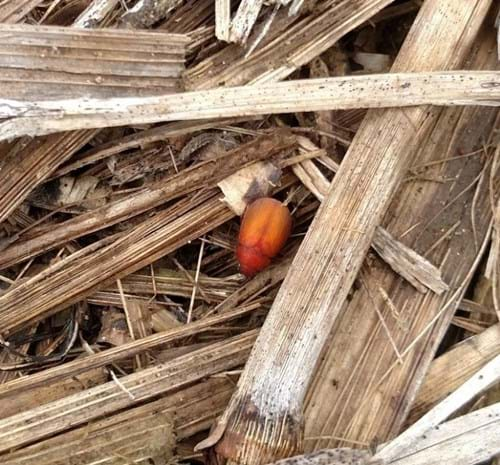
Newly emerged Asiatic garden beetles on June 23, 2017, in northern Kalamazoo County. Grubs, pupae and adults were found in the same areas in this field on this date. All photos by Bruce MacKellar, MSU Extension.
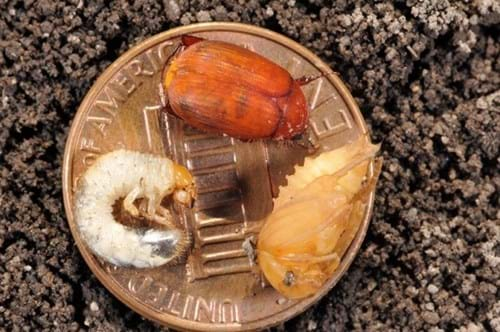
Photo credit: Bryan Jensen, Dept of Entomology and Division of Extension at University of Wisconsin
Amanda Goffnett, Dairyland Seed Agronomist, has encountered higher than normal wireworm issues in Michigan. Wireworms enjoy feeding on the seed directly. They are likely to infest fields with heavy residue and/or small grains the previous cropping year. This is where the CSI “Crop Stand Investigation” comes into play. Less than desired plant stands are a good indication of probable wireworm issues When and where you find missing plants, do some digging. The best management practice is to use bait stations prior to planting. Little can be done once damage has occurred. So, proactive management is the key with bait stations and use of insecticides at planting.
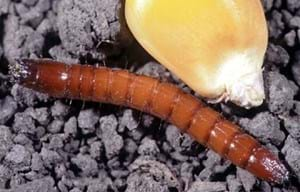
Larva (wireworm)
Photo by J. Obermeyer
We have also been keeping our eye on Black cutworm (BCW). Moth captures were relatively high as we reported earlier this year. As expected, we are also seeing some BCW larvae feeding. Typically, this isn’t a huge concern. There are localized environments where these numbers become problematic. For the largest majority of situations, it’s has been very scattered feeding.
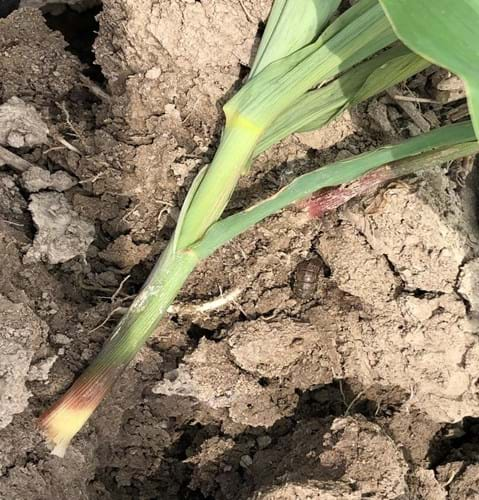
This photo was taken Monday in west central Indiana on June 5.
As always there are a plethora of critters that like to snack or sometimes make a meal out of our crops. Feel to call your Dairyland Seed professional for additional information if needed.
Resources:
https://www.canr.msu.edu/news/asiatic_garden_beetles_may_cause_corn_field_yield_losses_in_sw_mi
https://ipcm.wisc.edu/blog/2019/05/asiatic-garden-beetle/
https://extension.entm.purdue.edu/fieldcropsipm/insects/corn-wireworms.php
Corn Rootworm (CRW)
Corn rootworm larvae (CRW): If you are using non-traited or above ground only insect protection, and in continuous corn or in a traditionally heavy CRW area, the upcoming weeks are a good time to begin looking for feeding. We have observed fireflies or lightning bugs already.
What’s that have to do with CRW? Typically, these two insects have similar timing. When lightning bugs begin emerging CRW larvae begin hatching. And, when they hatch, they want to get a meal. Fully-traited corn fields in rotational situations are of lower priority in scouting. Those fields with no CRW traits or in a long-term corn rotation should be a higher priority. It is a good idea to check all fields as good stewardship management. Digging, transporting, washing and washing roots is standard procedure. In conventional corn tolerable levels tend to be eight rootworm or less when washing roots. As the season progresses high populations of adults can be a cause of significant silk feeding.
 |
 |
 |
 |
 |
| Brian Weller Western Region 507.456.3034 |
Dan Ritter Central Region 219.863.0583 |
Branden Furseth Northern Region 608.513.4265 |
Mark Gibson Eastern Region 260.330.8968 |
Amanda Goffnett Eastern Region 989.400.3793 |
